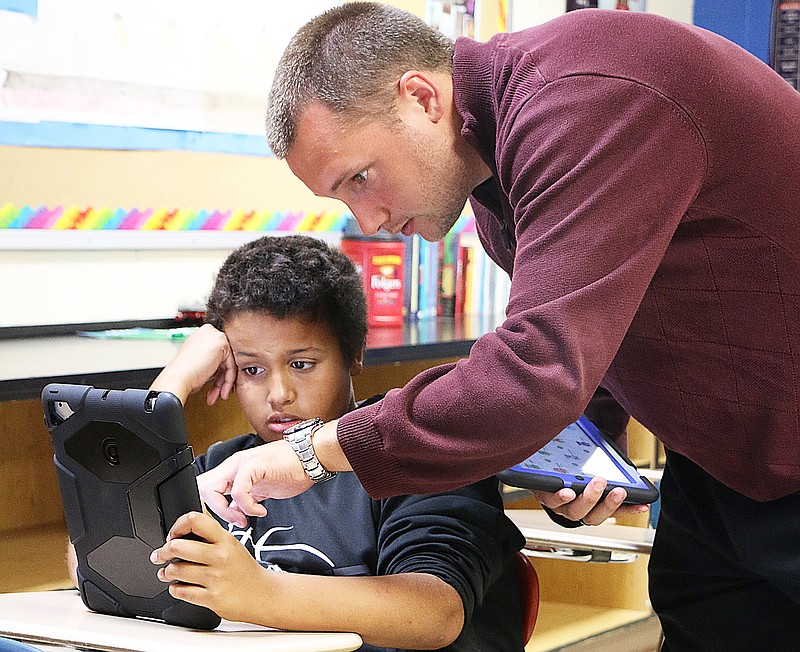Mary Van Orden, director of curriculum and instruction for South Callaway R-II Schools, said the days of a teacher standing in front of the room lecturing while students take notes is gone. Students, she said, must be interactive.
"We are going to be needing to change the way that classrooms operate," Van Orden said. "They need to be active, vital, dynamic living organisms."
The district put iPads in the hands of every student last fall. The year before that, they had a pilot program and gave iPads to the then fourth and seventh grade students.
Dustin Russell, 12, is a sixth grader who was in the fourth grade class that piloted the program.
"I was shocked that they were spending so much money (on the iPads). But it did work out pretty great," Russell said. "Everybody has fun using them."
Writing in the past was a subject Russell did not look forward to. The iPads, he said, have made learning more fun. Since getting the iPads, Russell said he pays closer attention during class activities. He added that his classes use more apps now then they did the first year his class piloted the iPads. However, he said using new apps can at times be a challenge because teachers are learning the apps, too.
Not long after handing out iPads district-wide, Van Orden said teachers asked for more support.
"Our teachers immediately gave us feedback about the fact that they needed some extra support in terms of learning ways to use the iPad not just as a substitute for paper and pencil activities but as a tool that will help them help our students learn at higher levels," Van Orden said.
Van Orden said the district was teaching in the same old way. As a teaching staff, she said they identified some key areas for the district's schools to focus on - increasing rigor, critical thinking and problem solving and technology integration
"Integrating technology at deep, deep levels so that it's transformative of the classroom experience instead of just a substitute is key to helping our kids graduate, being ready for college and career," Van Orden said.
Van Orden stressed that teaching practice needs to be strong and supportive of those focuses. Sarah Zolinski, middle school English/language arts teacher, echoed Van Orden's statement.
"Technology isn't going to replace good teaching practices, but it definitely gives us a lot more tools," Zolinski said.
South Callaway looked at other districts to see what they were doing, not only with technology, but with teaching strategies, too. Van Orden said in visiting other districts, they noticed a lot of schools had instructional or technology integration specialists. The idea, she said, is not new. But, the district had to decide how it wanted to utilize instructional coaches in its schools.
For a year, the district observed other schools' classrooms, surveyed its own teachers and discussed possibilities often. When the district surveyed its teaching staff, it found that most of them said they learned better from their peers than from other professional development sources and guest lecturers. For that reason, the administration decided to put a handful of teachers in a dual role as a teacher and an instructional coach. The coaches still teach a class but also serve as not only technology integration support but any kind of support a fellow teacher may need.
Each principal in the district recommended teachers - whom they thought would work well in the instructional coach role - to the superintendent. Each building has one instructional coach. The instructional coaches for each building are Liz Bittle, Early Learning and Childhood; Kathryn Zimmerman, elementary school; Danielle Hector, middle school; and Tucker Bartley, high school. In addition to an instructional coach, the high school also has instructional support teachers in each of the four main subject areas - social studies, science, math and English. Those four teachers teach a full load but have an extra plan period to assist teachers in their content area. The high school's content specific support teachers are Olivia Brandt, English/language arts; April Holzem, math; Carrie McDonald, science; and Tim Rulo, social studies.
Van Orden described the teachers chosen as veteran teachers. The coaches work in a non evaluative role when they observe classrooms in their building.
"It's very encouraging to see teachers helping teachers," Van Orden said. "It's very much a collaborative effort, all aimed at getting the student where the student needs to be."
Bittle, who has taught kindergarten for almost all of her 27 years in the district, has enjoyed getting to help students and teachers in her new role.
"This (being an instructional coach) is a new step for me," Bittle said. "I miss having my own set of kids all day long. But I get to spend time with every child in the building and their teachers."
Bittle said she has grown to love the mentoring aspect of her new role.
"I'm learning to really enjoy helping these young teachers," Bittle said. "Someone told me a long time ago that college isn't what makes great teachers, it's the teacher down the hall."

